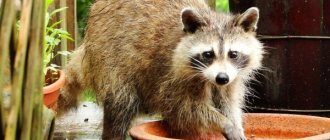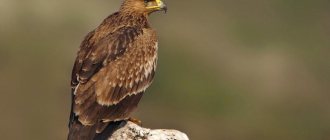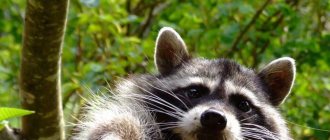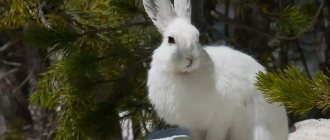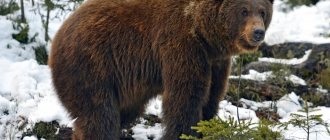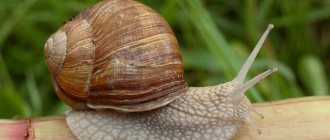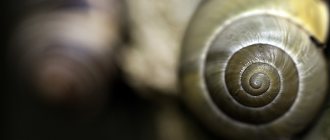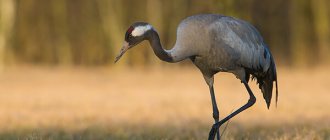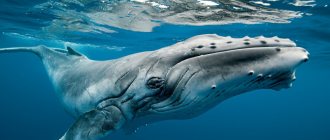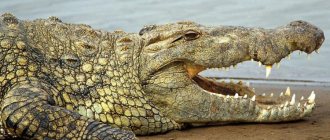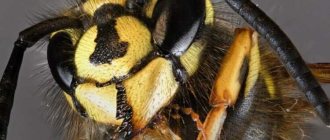Appearance
The appearance of predatory mammals resembles raccoon dogs. The animals have a stocky body, short legs, long fingers with claws. The back of the paw does not contain hair. When a raccoon stops, it rests on its entire sole; while moving, the main emphasis is on its fingers, so the pet’s tracks resemble a human hand.
Large head, short, sharp muzzle, small rounded ears. The entire body is covered with fluffy, long fur. It is noteworthy that the location of the fur on the sides of the head resembles sideburns. A raccoon's mouth can have between 36 and 42 teeth.
Since the raccoon loves to swim and spends a lot of time in water, the fur consists of thick undercoat, which makes up 90% of the total.
The yellowish-gray color of the animal includes black hairs. A black-brown stripe is clearly visible on the muzzle, located from the tip of the nose to the forehead. The area around the eyes is decorated with spots of a similar color.
The tail is unique; wide gray-yellow or black-brown rings are located parallel to each other over the entire surface. Males differ from females in their large size.
Where it lives: range and habitat
Each subspecies has its own habitat and special climatic conditions.
The striped raccoon is distributed in North America, ranging from the southern provinces of Canada to the Isthmus of Panama. The subspecies acclimatizes well to new living conditions, so it has spread throughout Europe: the predator can be found in Germany, France, Azerbaijan, Russia and Belarus (Polesie). Poloskun prefers to live in swampy areas, mixed and broad-leaved forests with lakes and rivers. In coniferous forests you can rarely find bodies of water, so the raccoon avoids such spaces.
for the raccoon or aguara is South and Central America, Tobago and Trinidad. Does not like proximity to other relatives, goes out hunting at night, prefers to be near lakes, rivers and streams.
The Guadalupe raccoon is a type of land animal. The main distribution area is the jungle of Guadeloupe. The main habitats are wetlands, but this species does not avoid dry forests, as long as there is a body of water nearby.
The Cozumel raccoon can only be found on a small island in the Caribbean. This species is endemic and does not live anywhere else except on a small island. Loves mangroves and is not afraid to be near beaches and cultivated areas.
Raccoons may have a main home and additional “apartments.” Animals occupy free hollows in trees located near water bodies. It is advisable that the hollow be at a height of 30 cm from the ground. You can tell that a raccoon lives in this house by the numerous scratches on the trunk and the remains of fur. Additional apartments are used only during the day; the raccoon spends the night in the main dwelling.
If an animal cannot find a suitable hollow for itself, it will gladly choose for its rest crevices located between huge stones or settle down among a pile of brushwood and branches.
Personally, raccoons have never dug holes, but taking a free hole is always welcome. Predatory mammals easily adapt to new conditions, so they can be found near human habitation - in the park area, not far from a populated area. A raccoon never moves more than 1.5 km from an occupied territory.
What does a striped raccoon eat?
The striped raccoon does not go far from water, but on the contrary strives to always remain nearby. The diet includes not only fish and frogs, but also freshwater crustaceans and turtles. Turtle eggs dug out of sand are the animal’s favorite treat. In the dense coastal thickets, they hunt only rodents - voles and hamsters, muskrats or musk rats.
Not only water and the coast serve as hunting grounds. A pest, that’s what residents of areas where the predator lives say about the striped raccoon. It penetrates chicken coops, destroys the nests of game birds, and damages fields, mainly corn fields. As soon as it does not find fields and water nearby, the animal looks for food in the forest, hunting for earthworms and larvae, insects and nests with eggs or chicks. If possible, eats berries, nuts and fruits.
Raccoon puppies, like adults, only when they are near populated areas, look for food in city landfills, and knock over garbage containers on the streets. Like primates, the animal uses its front paws when eating food. The gargle raccoon washes or rinses food before eating.
Lifestyle, behavior and character
Despite the fact that all varieties of raccoons belong to predatory mammals, they have a rather peaceful character, characterized by activity and excessive curiosity.
The animals are easy to train, since raccoons have the makings of intelligence. Having taught the animal certain commands, it will be happy to repeat them. However, the pet’s loyal attitude towards a person can end if he is accidentally offended - of course, in this situation the raccoon will not leave itself in trouble, it will definitely stand up for itself.
During defense, they release their claws, bite and make growling sounds, and threaten the offender. In case of danger, it often happens that raccoons prefer to simply run away from pursuit by other animals or pretend to be dead. They are wonderful actors, and they are good at it!
A friendly nature does not mean that raccoons like to live in groups. On the contrary, they prefer loneliness. They gather in groups only before the rut for procreation, and before wintering.
Each individual has its own territory, but they live in peace with their relatives, so their hunting places can overlap. Due to the fact that predators are tolerant of their own kind, raccoons densely populate territories. When meeting each other, the animals purr as if they are saying hello, and chirping and squealing can be heard.
Raccoons are sleepyheads, they are able to sleep all winter, as they do not like the cold season. For example, the duration of hibernation of the Canadian species is 6 months.
As soon as it starts to get dark, raccoons become active. During the day you can rarely see them, because they sleep peacefully in their main home. However, the habitat makes its own adjustments to the life of raccoons. For example, the life of mammals living near the coast depends on the ebb and flow of the tides. Raccoons in northern latitudes first store enough fat to sleep through the cold season in a warm place.
Raccoon predator or herbivore
There are many animals that attract the attention of adults and children. Often people do not want to have standard pets and prefer more exotic species, an example being the raccoon. Before making a responsible decision about the arrival of a new family member, you need to find out about his character and the conditions for comfortable coexistence.
The raccoon is a predatory mammal that lives in the vastness of America. If we consider Eurasia as a habitat for raccoons, then this continent is inhabited by only one species that has invaded an alien ecosystem - the striped raccoon.
Enemies
Wild animals are highly resistant to diseases, but can transmit them. This is worth remembering, especially when getting a raccoon as a pet. Predators actively defend themselves from other predators.
In some countries, sport hunting of raccoons is allowed. Over the course of a year, the number of cute mammals decreases by several million.
Stronger predators may attack raccoons. Animals are also attacked by coyotes, alligators, lynxes, and wolves.
Snakes prefer to hunt young individuals. In the regions of the Ciscaucasia, jackals exterminate raccoons, thus regulating the population size. Jackals are an invasive species, meaning they threaten biological diversity.
Kinds
In addition to the raccoons themselves, the Raccoon family includes nosukhi, olingo, kakimicili, and kinkajou. There are 4 species in the genus, although zoologists do not agree with the classification of the Guadalupe raccoon as a separate species. All animals have masks on their faces, a short ridged body, and protruding claws on their long fingers.
Gargle
The most common species, even though it has been the practice for a long time to hunt stripers for their valuable fur. The predator's homeland is North America. However, the animals quickly spread throughout Europe and quickly adapted to their new habitat.
The natural environment is quite strict and dangerous for raccoons. Animals lack large teeth and sharp claws, so they often become victims of foxes, wolves and bears.
Farmers treat raccoons poorly because they attack agriculture. But animals are naturally given dexterity, excellent vision and a lively mind. They are nocturnal, move easily in the dark, and sleep in winter.
The raccoon got its name due to the fact that it likes to rinse food before eating. And he does this procedure not because of cleanliness. Living near bodies of water, the raccoon looks for food at night, enters the water, sticks its paws into the mud, looks for larvae, crustaceans, and gets tadpoles. It looks like he is rinsing. Raccoons have an instinctive habit of scratching with their paws. If you give him a liver, he will rinse it so that it dissolves in water.
Raccoon raccoons previously had several subspecies, but they all became extinct. For example, Barbados raccoons lived on the island of Barbados, but they completely disappeared in 1960.
Rakoed
This species is less common than the gargle. Its natural habitat is Central and South America. Jungles and swamps are favorite places. Loves crustaceans, but does not like other foods. Unlike the striper, the fur is thinner, so in winter it does not sleep, as it constantly needs to warm itself. The crab beetle's body is slimmer, because it does not require increased accumulation of fat. Color can vary from gray-black to brown.
Cozumel
These are the smallest raccoons, in every way. They are the smallest species and the least widespread. They live on the island of Cozumel, Mexico. The number of Cozumel raccoons is only a couple of hundred. The appearance is similar to the striped raccoon. The tail has brown spots.
Guadalupe
Many zoologists classify the Guadalupe raccoon as a subspecies of the striped raccoon, but the first one differs in appearance. Habitat: Guadeloupe. Hunts at night, prefers swampy places, rivers, lakes. Does not hibernate.
Types of raccoons with photos and names
The genus “Raccoons” includes 3 main species:
Raccoons (Procyon lotor)
Which consists of 22 subspecies representing carnivorous mammals. Their peculiarity lies in the fact that they form the basis of a species that received its development in the process of progressive anthropogenic impact associated with land cultivation. The animal grows to a maximum length of 60 cm and has a tail up to 25 cm long. Individuals have fairly short legs and thick fur with a brownish-gray tint.
Raccoon-eating raccoons (Procyon cancrivorus)
Which is distinguished by a rather fluffy tail and a pronounced pattern around the eyes, reminiscent of a kind of “bandit mask”. They also grow up to 60 cm in length and no more, but at the same time they have a more streamlined body shape. The length of the tail varies between 20-40 cm. The main color of the body is brown, but the belly is distinguished by the presence of gray.
Cozumel raccoons (Procyon pygmaeus)
Which is a rather rare species, with a body length of up to 80 cm, but the tail length has standard dimensions, within a quarter of a meter. Adults gain weight up to 4 kg maximum. The main body color is brownish-gray, with a yellow color on the tail and a black mask on the muzzle.
Guadalupe raccoons (Procyon lotor minor)
Which is now considered an endangered species, although it has some similarities with the striped raccoon. The body length is the same as that of a striped raccoon, and there are about 6 black rings on the tail. The body is covered with relatively thick fur, and on the head there is a characteristic black mask.
It is important to know! The striped raccoon is considered the most common species, which includes more than 2 dozen subspecies. These subspecies also include some endemic subspecies that live within the islands.
The subspecies of the striped raccoon include an island subspecies that is considered very rare - the Barbados raccoon. Its natural habitats are limited to an island in the Caribbean Sea. This also includes such a large subspecies as the Tresmarias raccoon, as well as the Bahamian raccoon.
Raccoon food
Adaptation of animals is easy, since they can eat any food. The diet in the natural environment includes plant and animal foods:
- insects;
- bird eggs;
- aquatic life;
- acorns;
- hazelnuts;
- fruits.
Raccoons are not averse to eating berries, eating crabs, crayfish, toads, snakes, grass snakes, and chicks. In search of food, animals move to a distance of 1.5 m from their home.
Predator activity occurs at night. Despite their low weight, raccoons are excellent at climbing trees and destroying bird nests - both eggs and chicks are food for them.
Animals living near human habitation have a more varied menu. Raccoons love to climb through garbage pits and find leftover food there - pizza, bread, chips, sweet water. Local residents are tired of theft: raccoons break into the house and steal sweets and beer.
Swimming ability
Every raccoon simply loves water and everything that can be connected with it. These animals will definitely rinse their food in water if possible.
Just like otters, these animals settle closer to bodies of water. They are excellent swimmers, but very lazy. The mother begins to teach her babies to swim almost after birth, the babies begin to play on the shoreline in search of frogs and snails.
Interesting. They can spend three hours a day in water.
Reproduction
Polygamous raccoons try to impregnate as many females as possible during the rut. The mating season takes place during the cold season. Having impregnated one female, the gentleman immediately goes in search of a new lady of his heart.
The courtship does not last long. The male holds a twig in his front paws and rubs his head against it, scratching the ground, thus attracting an individual of the opposite sex.
The fact that the female is ready to mate is indicated by her specific smell. Only females care for the offspring; there is very little hope for gentlemen.
The female carries 4 to 5 cubs for a little over 2 months. Shortly before giving birth, she becomes overly aggressive. Completely helpless babies are born. The cubs weigh only 75 g and are born blind and deaf. Only towards the end of the first month of life do the cubs begin to distinguish objects. At first, newborns feed only on mother's milk. With the appearance of baby teeth, solid foods are introduced into the diet.
Babies are born naked, immediately begin to grow hair, and small black and white spots appear on their faces.
The babies are very voracious; the female feeds her cubs at least 24 times a day.
Communication between babies and mother occurs in a unique language that only they understand. More often the cubs squeak and the mother purrs or grumbles. With age, the voice becomes quieter. By autumn or winter, the cubs grow up and set off to conquer their territories.
Interesting facts about the striped raccoon
DID YOU KNOW THAT...
They say about the striped raccoon that it is able to open doors without effort, thanks to its tenacious fingers.
In 1955, a film was released about Dewi Crocket, who had a headdress made of striped raccoon fur with a tail; it was this style of cover that became fashionable at that time.
The species to which the predator belongs is called “lotor” - “one who rinses.” It has this name because the gargle raccoon most likely systematically rinses it with water before eating.
The taste of the animal's meat is similar to lamb fillet.
What does a striped raccoon look like?
VALUE
Height: ranges from 45 to 75 cm. Tail: ranges from 20 to 40 cm. Weight: before hibernation reaches 22 kg.
REPRODUCTION
The ability to mate: in females occurs at one year of age, and 2 in males. Mating games: take place in winter and can last until June. Gestation: 2-2.5 months. Puppies in a litter: 1-7, average 3-4.
LIFESTYLE
Customs: lonely hunter. Diet: omnivorous, preferring grains and nuts, fruits and food waste, reptiles and insects. Lives up to 10 years of age, sometimes longer.
RELATED SPECIES
Kinkajou and coati are closest relatives. Similar species include Procyon cancrivorus, the crab-eater raccoon, and Bassariscus astutus, which lives in North America.
Keeping at home
Before getting an animal as a pet, it is recommended to learn its habits in order to be prepared for unpleasant surprises.
Among lovers of exotic animals, the raccoon received the nickname “destroyer.” If he likes an item, he tries to take it away, hide it, and ultimately simply tear it apart. If the owner notices that the raccoon is trying to get to such an object, you should not hide it, even if it is dear to the owner. Firstly, it is useless, since the pet will find it anyway. Second, the raccoon may become overly aggressive.
If you had to leave the raccoon for a long time, you need to make sure there is food, water and enough space to move.
Cage or aviary
Keeping a striped raccoon is not considered difficult. This is a very friendly animal, although zoologists consider it the most restless. The raccoon is characterized by territorial intolerance - once inside the house, it considers the entire space to be its own. Therefore, curtains, furniture, sofa upholstery, wallpaper - this is his universe and he will definitely ruin them.
If you provide the raccoon with personal space, the percentage of damaged furniture will significantly decrease. Owners of private houses can provide the animal with their own home - build an open-air enclosure.
When keeping an animal in an apartment, it is advisable to give it a separate room, in which there will be no sockets, wires, or valuable furniture. Of course, few people can provide a raccoon with a separate room, so you need to buy a spacious cage in which it will live comfortably.
The minimum cage size should be 1 m2. However, the more, the better, since in cramped conditions the animal will soon become dull.
A raccoon in an enclosure can be placed on a glassed-in loggia. Animals love fresh air, but without drafts. In winter, the air temperature in the room with the animal should not fall below +10°C.
In the cage it is important to install a feeder, a drinking bowl, a basin of water and a container for the toilet. Since raccoons constantly rinse their food in water, it is recommended to replace it frequently.
Animals are clean, so they need bathing at least 2 times a year. In a large enclosure, it is advisable to make a playground so that the animal can have fun. It could be a small children's town or a Swedish wall.
Balanced diet
Veterinarians advise feeding raccoons at home with fruits and vegetables. The menu should include milk, fermented milk products, oatmeal and buckwheat porridge. The animal should be pampered with seafood, lean meats: rabbit, lamb and veal. You can give chicken, nuts, fish.
The raccoon menu should not contain the following products:
- flour products;
- sweets;
- marinades;
- spicy dishes;
- spiced products.
Many breeders neglect permitted and prohibited foods and continue to seek a completely balanced diet. Some people prefer to buy ready-made dry food in specialized stores, which is intended for feeding cats and dogs and is completely balanced. Others try to feed their pets natural food.
You shouldn’t judge either one or the other; you need to firmly decide for yourself what to feed your pet. Raccoons are omnivores, so their diet should be varied. Natural food best meets this principle, especially since it is easy to find. You can give a raccoon cottage cheese, nuts, yogurt, cookies, eggs.
Meat can be given raw, since in nature no one boils it. But in this case, it is important to give your pet anti-worm medications, because fresh food may contain their eggs.
The use of artificial food is possible only in extreme cases, when the pet’s health requires adjustment or when natural products are not available. Don’t worry if the gargle itself refuses some food, which means it doesn’t like it. The raccoon’s body itself decides which substances it has enough of and which deficiency should be replenished.
The pet's diet should contain food of plant origin:
- Vegetables (melons, pumpkins, zucchini).
- Fruits (bananas, plums, apricots, pears).
- Nuts (pistachios, hazelnuts, almonds, walnuts).
- Berries (gooseberries, mulberries, strawberries, grapes).
- Honey - in small quantities.
- Cereals (corn, buckwheat, rice and rolled oats).
In winter, the raccoon needs to be given dried fruits. Your pet will be happy with raisins, dates, figs, prunes, and dried apricots.
As a reward for good behavior, the raccoon can be given treats: cookies, kibble for dogs or cats, dried fruits. But some pets may refuse food offered as a reward. The point is that every owner must find out which foods the raccoon likes and which they don’t.
Feeding is carried out 3 times a day. If the owner is at work for up to 1700 hours, then the meal schedule should be as follows:
- breakfast – 800;
- lunch – 1800;
- dinner – 2300.
If the pet has been walking around the apartment for a long time and does not want to return to its cage, it is recommended to wait until it gets hungry and returns to its home for food - the hungry raccoon will return to its place without any extra coaxing.
In the summer, the striped raccoon takes on an unattractive appearance, which frightens its owners. By this time, the pet is losing a lot of weight and refuses food. By the end of the summer period, dramatic changes occur in the pet’s life and he begins to eat everything without understanding food. The fact is that in the fall the animal prepares for winter - it gains fat. In the spring the same thing happens - the raccoon loses weight. This process is completely normal and nothing to worry about.
Babies have a slightly different diet. Up to 3 months they feed on mother's milk. After 3 months, the menu can include soft curd mass, a slice of banana and a quail egg. Complementary foods should be introduced as for children - from a small volume. For example, for the first time, give 50 g of cottage cheese and 1 banana ring, mashed into puree.
Then chicken, finely chopped, and other types of lean meat: beef, veal are added to the menu. Gradually, you need to teach babies to eat on their own. When they start eating on their own, they will be great at determining the portion they need.
Communication with household members
A raccoon not only needs a balanced diet and a cozy enclosure to live in, the pet needs communication with its owners. Without their attention, the animal will soon “go out.”
It is not allowed to keep your pet locked up all the time; from time to time it is necessary to allow it to raid the apartment, but under close supervision.
Is it possible to punish a pet?
When buying a raccoon, everyone is warned about its pranks, so you should not use physical force on your pet, otherwise it will become overly aggressive.
Despite the fact that people have been able to tame the animals, they are wild by nature, so you will have to come to terms with their wayward behavior. You cannot offend a small predator, otherwise he will become an angry and ferocious warrior.
How to choose puppies
You need to buy babies who are 6-8 months old. The smaller the pet, the easier it is to train. We must not forget about the need for vaccination.
It is worth remembering that as a pet grows up, it can show excessive aggression, especially during puberty. At this time, the raccoon is ready to protect its territory from everyone, and may even keep its owner away.
